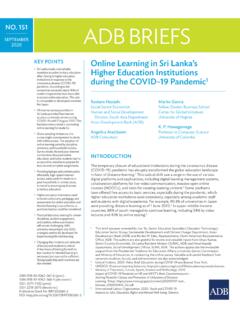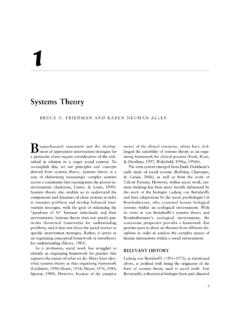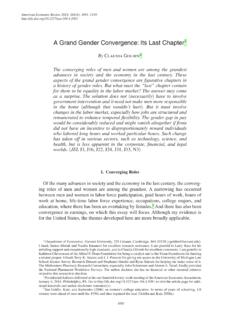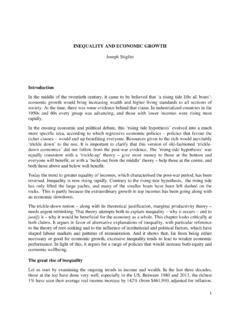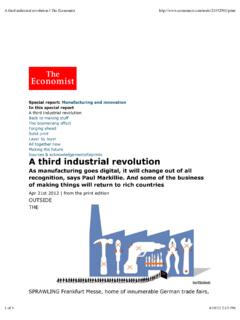Transcription of Brief 5: Evaluating Policy Impact
1 Step by Step Evaluating Violence and Injury Prevention Policies Brief 5: Evaluating Policy Impact This Brief discusses how to implement Step 3 of the Framework for the third of the three main phases of Policy evaluation: Policy Impact evaluation. Purposes of Policy Impact Evaluation Policy Impact evaluation can have multiple aims or purposes, including: Demonstrating the Impact of the Policy , by measuring changes in short- term, intermediate and long-term outcomes. Determining whether changes in outcomes can be attributed to the Policy . Comparing relative impacts of policies with different components. Identifying the relative cost-benefit or cost-effectiveness of a Policy . The focus of the evaluation may be a number of different areas, including the following: Short-term, intermediate, and long-term outcomes and impacts. Policy Impact Evaluation: Did the Policy Produce the Intended Outcomes are short-term and intermediate changes Outcomes and Impacts?
2 In target audience behavior, awareness, attitudes, or knowledge. Policy Impact evaluation examines changes Impacts are long-term changes in indicators. in key indicators that have occurred since Indicators are specific, observable, measurable the implementation of a Policy and the characteristics of changes that demonstrate progress extent to which changes can be attributed toward outcome or Impact . to the Policy . Policy Impact evaluation's Outcomes and impacts in comparison communities. relation to Policy development phases is Costs of implementing the Policy . illustrated in Figure 1. Cost savings resulting from Policy implementation. Examples of outcome and Impact indicators are presented in Figure 2. National Center for Injury Prevention and Control Sample Impact Evaluation Questions Evaluating Impact of Product Once the purpose and focus of the evaluation are determined, Design Changes you should identify specific evaluation questions.
3 The evaluation questions you choose will guide your selection of an To evaluate a voluntary performance appropriate evaluation design. The following are some sample standard for infant walkers that Policy Impact evaluation questions. suggested that walkers be designed to be too wide for a standard doorway Was there a change in the outcomes and impacts of or incorporate a braking mechanism, interest? Shields and Smith found a 75% decrease Did the Policy contribute to a change in the outcomes and in infant-walker related injuries by impacts of interest? conducting a retrospective pre-post Were there any unintended consequences of the Policy ? design that examined injury rates before Did contextual factors influence the level of Impact ? and after the standard was established. What was the economic Impact of the Policy (cost- This decrease was demonstrated through effectiveness or cost benefit)?
4 A retrospective analysis of data from the National Electronic Injury Surveillance Evaluation Design Considerations System maintained by the Consumer Product Safety Evaluating a Change in Outcomes, and Impacts When the evaluation question focuses on identifying changes in the indicators, regardless of whether or not the changes were necessarily a result of the Policy itself, the team can use non-experimental or descriptive designs. However, be sure to represent accurately what the results of this analysis demonstrate. Non- experimental designs are unable to clearly link the impacts to the Policy because they are unable to rule out alternative explanations for the These types of designs are most appropriate when it is impossible or impractical to compare changes over time or to use a comparison group . Two potential non-experimental designs for Impact evaluation are cross-sectional and case Establishing a Link Between a Policy and Changes in Outcomes and Impacts A randomized experimental design is sometimes considered the gold standard for conducting an Impact evaluation because it produces the strongest evidence that a project, program, or Policy contributed to changes in behavior or other ,4,5 However, when you are Evaluating the Impact of a Policy on a population, randomization may be unethical or impossible, not to mention costly or time-consuming.
5 Quasi- experimental designs can be used to evaluate changes in indicators over time or compared to a group not affected by the Policy . Refer to Appendix O for further description of these methods. 6. 1 Her Majesty's Treasury. (2011). The magenta book: Guidance for evaluation. London, UK: Author. Retrieved from 2 Shields, B. J., & Smith, G. A. (2006). Success in the prevention of infant walker-related injuries: An analysis of national data, 1990 2001. Pediatrics, 117, e452-e459. 3 W. K. Kellogg Foundation. (1998; rev. 2004). Evaluation handbook. Battle Creek, MI: Author. Retrieved from center/resources/2010 4 Patton, M. Q. (2011). Essentials of utilization-focused evaluation. Saint Paul, MN: Sage. 5 Brownson, R. C., Royer, C., Ewing, R., & McBride, T. D. (2006). Researchers and Policy makers: Travelers in parallel universes. American Journal of Preventive Medicine, 30, 164 172.
6 6 Markowitz, S., Nesson, E., Poe-Yamagata, E., Florence, C., Roberts, T., & Link, S. B. (2011, June). Estimating the relationship between alcohol policies and youth violence. Retrieved from 2 Step by Step Evaluating Violence and Injury Prevention Policies A number of factors can make it easier or harder to make the case for a causal relationship between the Policy and the observed changes in outcomes. These factors include the following2: Nature of the relationship between the Policy and the impacts. Expected magnitude of change in Impact . Expected length of time to see evidence of the Policy effects. Nature and extent of external influences on Impact . Availability of data. Extent of implementation (availability of natural comparison groups). Comparison Groups In many cases, you may be able only to assert some contribution of the Policy to the outcomes and impacts.
7 Using Modeling the Impact of Alcohol comparison groups is one method that can increase your Control Policies on Youth Violence confidence that the Policy is responsible for the change in Using data from the Youth Risk Behavioral indicators. A comparison between groups whose members Surveillance Survey as well as area-level have not been randomly assigned is known as non-equivalent alcohol Policy information, Markowitz comparison design. Although groups similar to the community and colleagues used statistical modeling or group being affected by the Policy may be selected, the to examine the Impact of various alcohol groups are not equivalent, regardless of how similar they may control policies on measures of youth appear. Some additional steps may be required during analyses violence and drinking. They obtained and interpretation to demonstrate the appropriateness of data on 18 different alcohol control the comparison If you are unable to compare a group Policy variables from the Alcohol Policy affected by a Policy with a group not affected by a Policy , you Information System (available from the may be able to make comparisons between the groups that National Institute on Alcohol Abuse and have been affected by a Policy .)
8 For example, an evaluation Alcoholism) and also contacted state may compare the Impact of a universal school-based violence officials directly. Merging this information prevention Policy between different schools, different grade with violence data based on respondent levels, or different levels of implementation. residence and year of survey allowed for an analysis of the relationships between Evaluation of Cost Versus Benefit8 the different policies and youth violence. The analyses provided evidence of a Economic evaluation methods compare the costs of the negative relationship between alcohol Policy with the resulting benefits. These methods are used prices and youth in conjunction with the designs described above because they are dependent upon understanding the amount and types of changes that occurred as a result of the program. Economic evaluations attempt to place a value on these changes and then compare this value with the cost of implementing the program.
9 Two types of economic evaluations are cost-benefit and cost-effectiveness studies. Cost-benefit studies estimate and compare the cost of a Policy with the value of the benefit of the Policy . Cost-effectiveness studies examine the cost-\ of implementing Policy in relation to the resulting positive outcomes or impacts, often in comparison 7 CDC, Office of the Associate Director for Program. (2012, September). A framework for program evaluation. Retrieved from eval/ 8 Faul, M., Wald, M. M., Rutland-Brown, W., Sullivent, E. E., & Sattin, R. W. (2007). Using a cost-benefit analysis to estimate outcomes of a clinical treatment guideline: Testing the Brain Trauma Foundation guidelines for the treatment of severe traumatic brain injury. Journal of Trauma, 63, 1271 1278. 3 Step by Step Evaluating Violence and Injury Prevention Policies to alternative policies or interventions.
10 It is important to consider a wide range of Estimating the Cost-Benefit of a Policy potential costs and benefits related to the Policy in order to account for ripple effects To examine the cost savings associated with adopting the when Evaluating cost and benefits. Economic Brain Trauma Foundation (BTF) guidelines for treatment analyses can be extremely complicated and of severe traumatic brain injury, Faul and colleagues used should be thoroughly planned with input from surveillance systems combined with national surveys. an economist, econometrician, or quantitative They estimated the lifetime costs of 80% adherence to the Policy research expert during the planning guidelines compared with the 33% estimated adherence. phase of the Using a decision analysis model, coupled with previous research and available surveillance and survey data, they estimated savings of more than $300 million in medical General Measurement Considerations costs and rehabilitation costs if the BTF guidelines were Impact evaluations typically rely on followed at 80% adherence.










